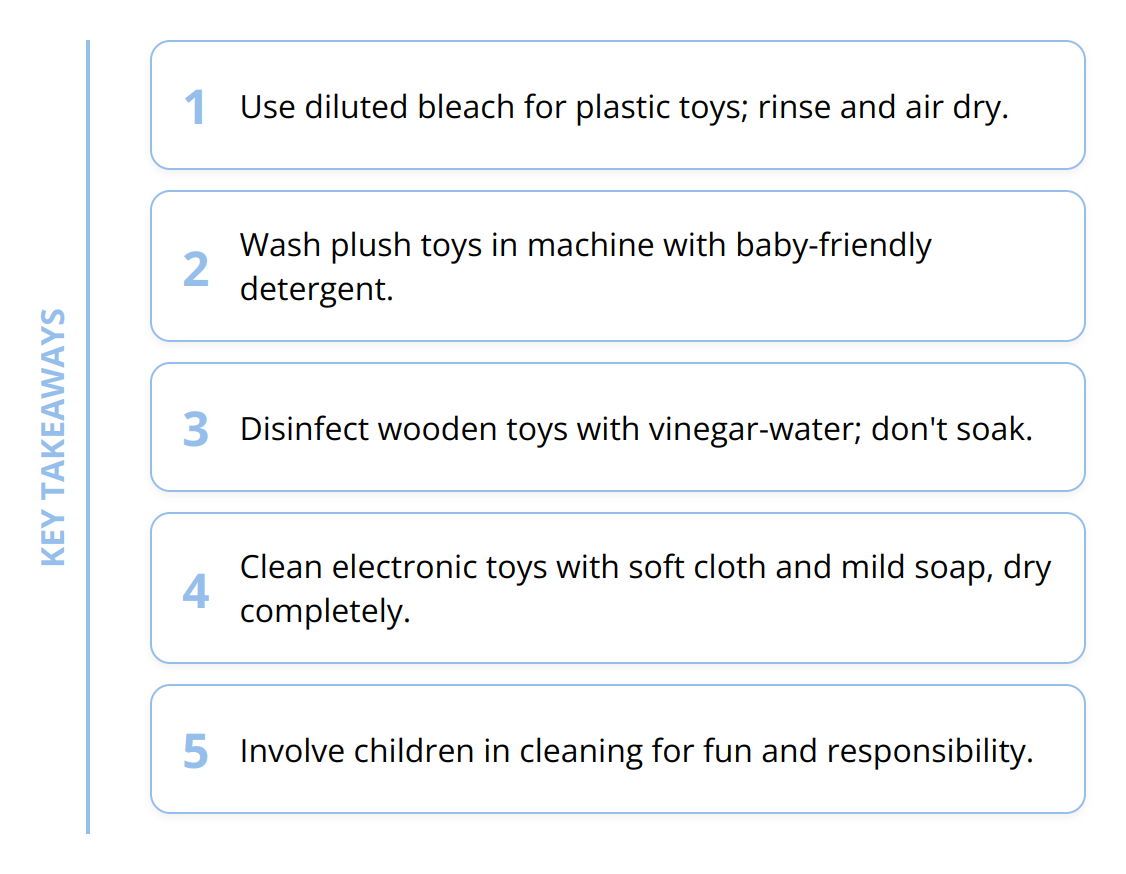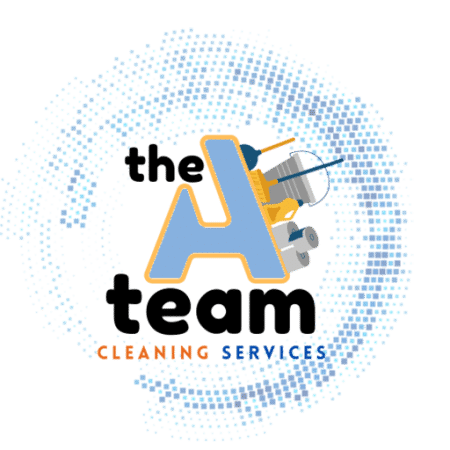Keeping children’s play areas and toys clean is vital for their health and safety. That’s why we at The A Team Cleaning Services have put together practical advice on sanitizing toys quickly and effectively.
In this blog post, you’ll learn about the best cleaning agents, methods for different toy materials, and how to maintain a regular cleaning schedule. This guide is designed to help you ensure your children’s toys are always safe and hygienic.
Selecting Safe Sanitizers
When it comes to keeping children’s toys clean, the choice between natural and chemical sanitizers is more important than you might think. Each has its place, but understanding when and how to use them can make a world of difference in safety and effectiveness.
Natural Cleaners: For everyday cleaning, natural options like vinegar or a mix of water and baking soda are excellent choices. They’re safe for most types of toys and are effective at removing grime without leaving harmful residues. However, while they clean, they might not always disinfect to the level needed when dealing with certain germs.
Chemical Cleaners: Chemical sanitizers, like diluted bleach solutions or alcohol-based products, are unbeatable when you need to disinfect toys thoroughly, especially during flu season or after an illness in the house. Yet, they require careful handling to avoid damaging toys or exposing children to toxic substances.

Best Practices Based on Toy Material
- Plastic Toys: Often, plastic toys can handle more robust cleaning agents. A diluted bleach solution (1 tablespoon of bleach to 1 gallon of water) can disinfect effectively without causing harm to hard plastics. After disinfecting, rinse with water and let the toy air dry.
- Wooden Toys: Wood is porous and can be damaged by harsh chemicals. Opt for wiping with a mild soap solution and water. Consider using a vinegar-water mix for a natural clean but avoid soaking to prevent warping or damage.
- Plush Toys: Check care labels first. Many plush toys are machine washable, a simple and effective cleaning method. For spot cleaning, gentle soap with water or a vinegar-water solution can be used. Ensure they are thoroughly dried to prevent mold growth.
- Silicone and Rubber Toys: These are usually safe to clean in the dishwasher on a top rack. If hand-washing, soap and warm water work well, followed by a vinegar-water rinse for a natural disinfecting.

Safety Tips When Using Sanitizing Agents
- Always Follow Directions: Whether it’s a natural solution or a commercial product, following the usage instructions is vital.
- Ventilate: Ensure good airflow when using chemical cleaners to avoid inhaling fumes.
- Rinse Well: Especially with chemical sanitizers, rinsing toys thoroughly with water after cleaning ensures no residue is left behind.
- Dry Completely: Moisture is a breeding ground for bacteria and mold. Make sure toys are entirely dry before returning them to play areas.
Cleaning and sanitizing children’s toys need not be a daunting task. With the right sanitizing agents and methods tailored to different materials, you can keep playtimes both fun and hygienic. For more tips on creating a safe, clean environment for your family, explore our guides on allergy-safe cleaning practices and home disinfection.
Quick Toy Cleaning Techniques
Keeping toys clean is essential, but it shouldn’t take away from playtime. Here are straightforward methods to sanitize toys based on their type, ensuring they’re safe and ready for your child’s next adventure.
Soft Toys: Clean and Cozy
Soft toys are beloved by children but can harbor bacteria and allergens. Here’s how to keep them clean:
- Machine Washable: Most soft toys can go in the washing machine. Use a gentle cycle and baby-friendly detergent. For extra protection, place toys in a pillowcase or mesh laundry bag.
- Hand Washing: For those that can’t be machine-washed, use warm soapy water for a thorough hand wash. Scrub gently and rinse well.
- Dry Thoroughly: Air dry or use a dryer on a low setting. Ensure toys are completely dry to prevent mold.
Consider reading our guide on washing techniques for soft toys for more detailed advice.
Hard Toys: Swift Sanitization
Plastic, wooden, and other hard toys need regular disinfection, especially if shared or used outside.
- Diluted Bleach Solution: Mix 1 tablespoon of bleach with 1 gallon of water for a powerful disinfectant. Soak toys for a few minutes, rinse with water, and air dry.
- Alcohol-based Wipes: Great for a quick disinfection. Wipe toys thoroughly and let them air dry. Avoid on painted or porous toys as it may cause damage.
- Dishwasher Safe: Plastic toys without batteries can often be cleaned in the dishwasher. Use a gentle detergent and place them on the top rack.

Electronic Toys: Keeping Tech Clean
Electronic toys add fun and educational value but require careful cleaning to avoid damage.
- Battery Removal: Always remove batteries before cleaning.
- Soft Cloth and Mild Soap: Gently wipe the toy’s surface. Avoid moisture near charging ports or buttons.
- Disinfectant Wipes: Use alcohol-free wipes to avoid damage. Focus on the parts that come into contact with hands.
- Dry Completely: Before replacing batteries or plugging in, ensure the toy is thoroughly dry.

Quick Tips:
- Regular cleaning schedules prevent buildup of germs.
- Combine cleaning with playroom organization for efficiency.
- Disinfect high-touch areas regularly, especially during flu season or after illness.
After cleaning, consider organizing your play area for a more efficient and enjoyable playtime. Tips on organizing can be found in our guide on quick garbage sorting and organizing tips.
Adopting these practices ensures toys are not only clean but safe for everyday play, offering peace of mind and more time for fun.
Regular Cleaning Schedule
Setting up a regular sanitizing schedule for toys is key to maintaining a healthy play environment for kids. It ensures that toys remain free of harmful germs and bacteria, reducing the risk of illness. Here’s how to make toy cleaning manageable and even enjoyable.
Create a Cleaning Calendar
A calendar is an effective tool in keeping track of cleaning tasks. It doesn’t have to be complicated. Start by assigning specific toys to be cleaned on certain days of the week. For example, plush toys could be washed every Saturday, while hard toys get sanitized every Wednesday. Adjust the frequency based on usage – toys used daily might need more frequent attention. Marking these tasks on a calendar serves as a reminder and helps distribute the cleaning workload evenly over time. Remember, consistency is more effective than sporadic deep cleaning sessions.
Make It a Family Activity
Involving children in the cleaning process not only teaches them responsibility but also makes the task less tedious. Turn cleaning into a game or a fun challenge. For younger children, you could sing songs about cleaning while you work together, or for older kids, set up a timer to see who can organize and clean their toys the quickest. Reward them with more playtime or a favorite activity afterward. This approach not only gets the job done faster but also instills in them the importance of cleanliness from an early age.
Declutter Regularly
One undeniable truth is that less clutter means less cleaning. Regularly go through toys with your children and decide which ones can be donated, recycled, or need to be thrown away. This not only reduces the number of toys that need cleaning but also teaches children about letting go of things they no longer use or need. A decluttered space is also quicker to organize, making the cleaning process more efficient.
For more insights on decluttering and its benefits, explore our guide on eco decluttering strategies.
Tips for a Successful Cleaning Routine
- Frequency Matters: High-touch toys require cleaning several times a week, while others might need less frequent attention.
- Storage Solutions: Invest in easy-to-clean storage options to keep toys organized and reduce dust accumulation.
- Safety First: Regularly inspect toys for damage during cleaning sessions to prevent accidents.
- Involve Kids: Teaching children the importance of cleanliness can make them more cooperative during cleaning sessions.

Adopting a structured approach to toy cleaning ensures that children’s playthings are always ready and safe for the next adventure. By turning cleaning into a routine activity, it becomes part of normal life, reducing stress and keeping your home a healthy environment.
Final Thoughts
In wrapping up, we’ve explored various effective sanitizing techniques that cater to different types of toys, ensuring they remain clean and safe for our children. Emphasizing the importance of toy hygiene cannot be overstated. Regular cleaning and sanitizing of toys protect our children from harmful microbes and support a healthy living environment.

Consistent cleaning habits are essential. Establishing a regular cleaning schedule for toys not only keeps them in good condition but also helps instill a sense of responsibility in children regarding cleanliness. From soft plush toys to hard plastic playthings, each requires a specific approach to cleaning, and we’ve detailed practical methods to achieve this efficiently.
Remember, maintaining a healthy play environment for kids goes beyond just toys. It encompasses the whole house, and that’s where we at The A Team Cleaning Services come in. Our professional cleaning services can complement your efforts by ensuring your home is not only clean but hygienic, providing a safe space for your family to thrive.
Explore our range of cleaning services to discover how we can help you maintain a pristine home, allowing you more time to focus on what matters most. Visit us at A Team Cleaning Services for more information and to schedule your cleaning today.
In conclusion, the safety and health of our families start with maintaining cleanliness in every part of our lives, including the toys our children cherish. By adopting the right cleaning practices, we not only safeguard their health but also contribute to creating a nurturing environment. Let’s make consistent cleaning habits a part of our routine, ensuring our homes remain welcoming and safe havens for every family member.
